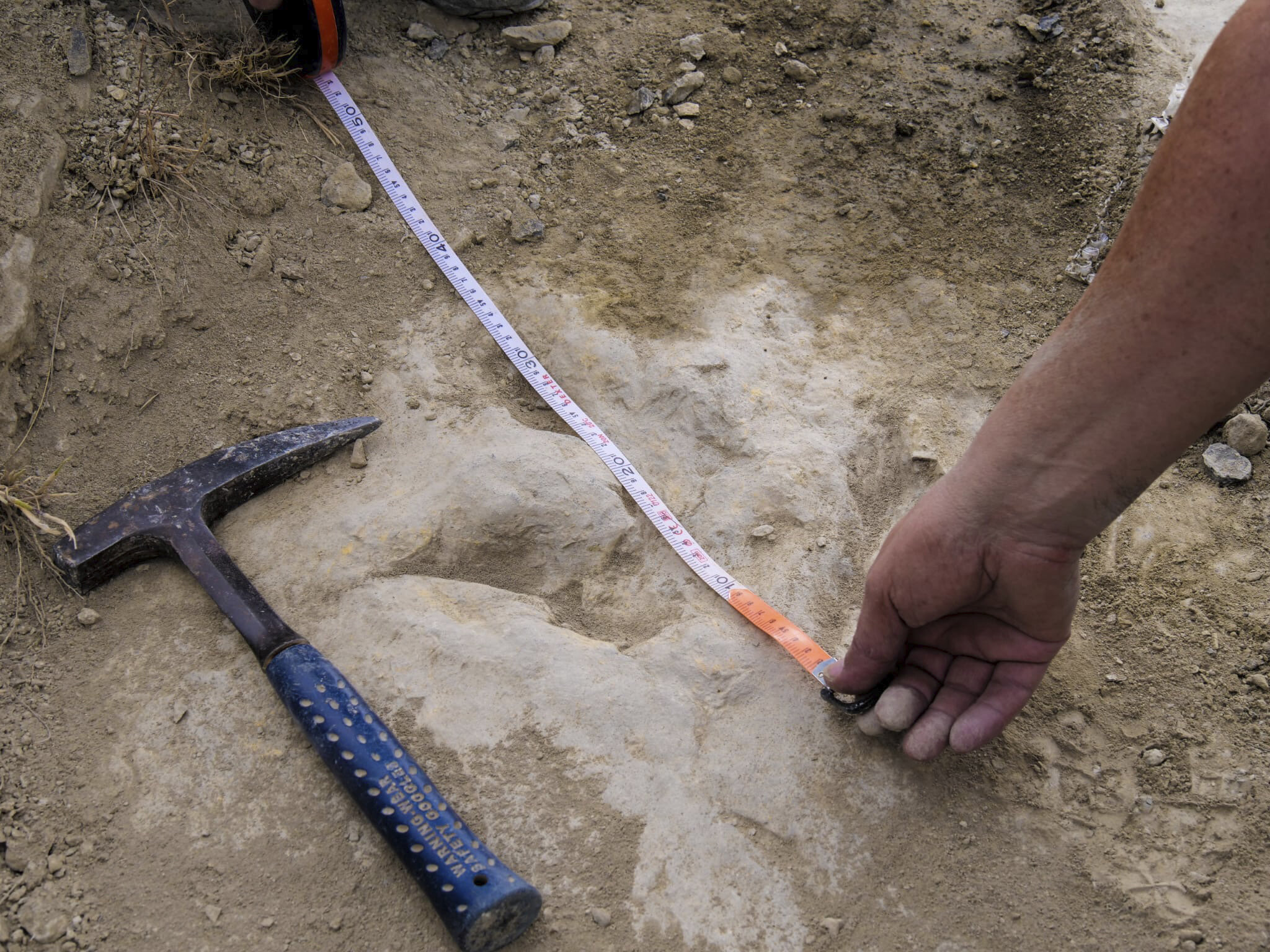#Footprints show some two-legged dinosaurs were agile

“#Footprints show some two-legged dinosaurs were agile”
by Emma H. Tobin </p><div>
<div class="article-gallery lightGallery">
<div data-thumb="https://scx1.b-cdn.net/csz/news/tmb/2021/footprints-show-some-t.jpg" data-src="https://scx2.b-cdn.net/gfx/news/hires/2021/footprints-show-some-t.jpg" data-sub-html="In this October 2020 photo provided by Alberto Labrador, a researcher measures a 120 million year-old fossilized dinosaur footprint the in the La Rioja region in northern Spain, while doing research about dinosaur running speeds. Scientists discovered one of the quickest sets of theropod tracks in the world through this research. Credit: Alberto Labrador via AP">
<figure class="article-img">
<img src="https://scx1.b-cdn.net/csz/news/800a/2021/footprints-show-some-t.jpg" alt="Footprints show some two-legged dinosaurs were agile" title="In this October 2020 photo provided by Alberto Labrador, a researcher measures a 120 million year-old fossilized dinosaur footprint the in the La Rioja region in northern Spain, while doing research about dinosaur running speeds. Scientists discovered one of the quickest sets of theropod tracks in the world through this research. Credit: Alberto Labrador via AP" width="800" height="530"/>
<figcaption class="text-darken text-low-up text-truncate-js text-truncate mt-3">
In this October 2020 photo provided by Alberto Labrador, a researcher measures a 120 million year-old fossilized dinosaur footprint the in the La Rioja region in northern Spain, while doing research about dinosaur running speeds. Scientists discovered one of the quickest sets of theropod tracks in the world through this research. Credit: Alberto Labrador via AP
</figcaption> </figure>
</div>
Not all two-legged dinosaurs were like the lumbering Tyrannosaurus rex.
An analysis of dinosaur tracks from 120 million years ago unearthed in Spain adds to growing evidence that these meat-eating prehistoric beasts belonging to the same group as T.rex could be highly agile.
The findings, published Thursday in Scientific Reports, reveal one of the fastest known sets of fossilized dinosaur footprints.
These tracks join the ranks of other speedy sets found in Utah and Texas, one of which shows dinosaurs running at speeds over 30 mph. The Spanish footprints showed speeds of nearly 28 mph.
To calculate the running speed, scientists measured the length of the footprint and took into account the dinosaur’s hip height and stride length—the distance between two consecutive footprints of the same foot.
All of the fastest known sets of prints come from a family of dinosaurs called theropods. These carnivorous dinosaurs stood on two legs and could not fly, like the famed velociraptor. The animals that created the most recent impressions were probably 5 to 6 1/2 feet tall and 13 to 16 feet long from mouth to tail, the researchers estimated.
Scientists think there may be other faster dinosaurs, but the tracks of theropods have been easier to track down.
“Behavior is something very difficult to study in dinosaurs,” said lead author Pablo Navarro-Lorbés of the University of La Rioja. “These kind of findings are very important, I think, for improving that kind of knowledge.”
Scientists typically predict dinosaur behavior through computer modeling of the creatures’ movement. Physical examination of fossilized footprints confirm the results.
These are “clearly active, agile animals,” said Smithsonian paleontologist Hans Sues, who had no role in the study.
<div class="article-main__explore my-4 d-print-none">
International paleontology team discovers tiny cat-sized stegosaur
</div>
<hr class="mb-4"/>
<div class="article-main__more p-4">
<strong>More information:</strong>
Pablo Navarro-Lorbés et al, Fast-running theropods tracks from the Early Cretaceous of La Rioja, Spain, <i>Scientific Reports</i> (2021). <a rel="nofollow noopener" target="_blank" data-doi="1" href="http://dx.doi.org/10.1038/s41598-021-02557-9">DOI: 10.1038/s41598-021-02557-9</a>
</div>
<p class="article-main__note mt-4">
© 2021 The Associated Press. All rights reserved. This material may not be published, broadcast, rewritten or redistributed without permission.
<!-- print only -->
<div class="d-none d-print-block">
<strong>Citation</strong>:
Footprints show some two-legged dinosaurs were agile (2021, December 9)
retrieved 9 December 2021
from https://phys.org/news/2021-12-footprints-two-legged-dinosaurs-agile.html
This document is subject to copyright. Apart from any fair dealing for the purpose of private study or research, no
part may be reproduced without the written permission. The content is provided for information purposes only.
</div>
</div><script id="facebook-jssdk" async="" src="https://connect.facebook.net/en_US/sdk.js"></script>
If you liked the article, do not forget to share it with your friends. Follow us on Google News too, click on the star and choose us from your favorites.
For forums sites go to Forum.BuradaBiliyorum.Com
If you want to read more Like this articles, you can visit our Science category.



